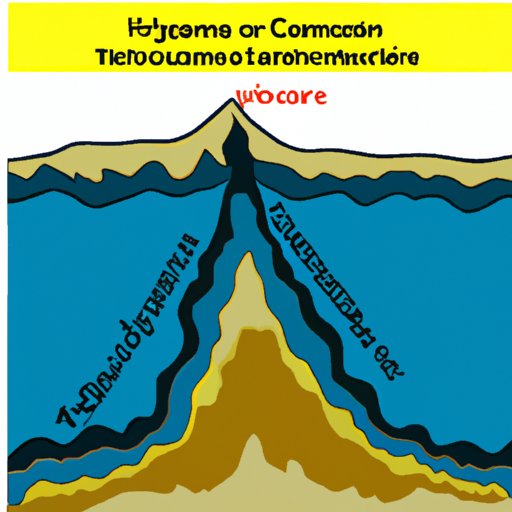Introduction
A tsunami is an immense wave of water that is caused by an underwater disturbance, such as an earthquake or volcanic eruption. These waves can reach heights of up to 100 feet and travel at speeds of up to 500 miles per hour, making them one of the most destructive natural disasters on Earth. As such, they are a major concern for coastal communities around the world, as they can cause significant damage and loss of life when they strike land. But where are tsunamis most common? To answer this question, it is important to examine the causes and effects of tsunami incidents around the world.
Analyzing Historical Tsunami Events and Determining Where They are Most Common
The best way to determine where tsunamis are most common is to examine patterns in past tsunami incidents. By studying the location and frequency of previous tsunami events, it is possible to identify areas of the world that are more prone to these devastating waves. For example, the Pacific Ring of Fire is an area of intense seismic activity that runs along the coastlines of the Pacific Ocean, and it is one of the most active regions in terms of tsunami occurrences. The 2004 Indian Ocean tsunami, which killed over 230,000 people, is another example of a major event that occurred in this region.
It is also important to investigate the location of major tsunami events. For instance, the 2011 Japanese tsunami was caused by an undersea earthquake off the coast of Japan, while the 1960 Chilean tsunami was triggered by a massive magnitude 9.5 quake in the South Pacific Ocean. In both cases, the tsunamis were generated close to the coastlines of these countries, suggesting that coastal areas are particularly vulnerable to these types of disasters.
Examining Geographical Factors that Increase the Risk of a Tsunami Occurring
In addition to examining historical events, it is important to consider geographical factors that can increase the risk of a tsunami occurring. One of the most important factors is topography, as steep slopes can amplify tsunami waves and make them even more destructive when they reach land. This is why many coastal areas are at higher risk of experiencing a tsunami, as their sloped terrain amplifies the wave’s power.
Another important factor is the relationship between earthquakes and tsunamis. When an earthquake occurs beneath the ocean, the seismic energy triggers an underwater displacement of water, which then creates a series of powerful waves known as a tsunami. This is why earthquakes are often the cause of major tsunami events, as they have the potential to generate huge amounts of energy and cause large-scale destruction.

Investigating the Effects of Plate Tectonics on Tsunami Frequency
Plate tectonics also play an important role in determining where tsunamis are most common. Subduction zones, which are areas where two tectonic plates meet and one plate slides underneath the other, are particularly susceptible to producing tsunamis. This is because the movement of the plates can cause large-scale displacements of water, leading to powerful waves when they reach land. In addition, continental shelves can also contribute to tsunami formation, as they act as barriers that trap energy and amplify the size of the wave when it reaches shore.

Exploring the Role of Oceanic Currents in Tsunami Occurrences
Oceanic currents are another factor that can influence the frequency of tsunamis. Surface currents are responsible for carrying water away from the coastline, which can reduce the impact of a tsunami when it reaches land. On the other hand, deep sea currents can carry energy from the ocean floor to the surface, which can then be amplified when it reaches shallow waters near the shoreline. Both of these factors can play a role in determining where tsunamis are most common.

Comparing Tsunami Incidents Around the World
When comparing tsunami incidents around the world, it is important to consider regional differences in tsunami frequency. For example, the Pacific Rim is particularly prone to tsunamis due to its high level of seismic activity, while the Caribbean Sea is less prone due to its relatively calm waters. Additionally, climate change can also play a role in determining where tsunamis are most common, as rising sea levels can put coastal communities at greater risk of flooding and destruction.
Assessing the Impact of Human Activity on Tsunami Formation
Finally, it is important to assess the impact of human activity on tsunami formation. Coastal development can increase the risk of tsunami destruction, as it can create obstacles that block the wave’s path and cause it to become more powerful when it reaches land. On the other hand, human-made structures such as seawalls and breakwaters can help to protect coastal areas from the destructive force of tsunamis. Therefore, it is important to consider the effect of human activity when assessing where tsunamis are most common.
Conclusion
In conclusion, tsunamis are most common in areas with high levels of seismic activity, such as the Pacific Ring of Fire. Geographical factors such as topography and plate tectonics can increase the risk of a tsunami occurring, while oceanic currents can influence the size and intensity of the wave when it reaches land. Additionally, climate change and human activity can also play a role in determining where tsunamis are most common. For more information on tsunamis and their effects, please refer to the resources provided.


